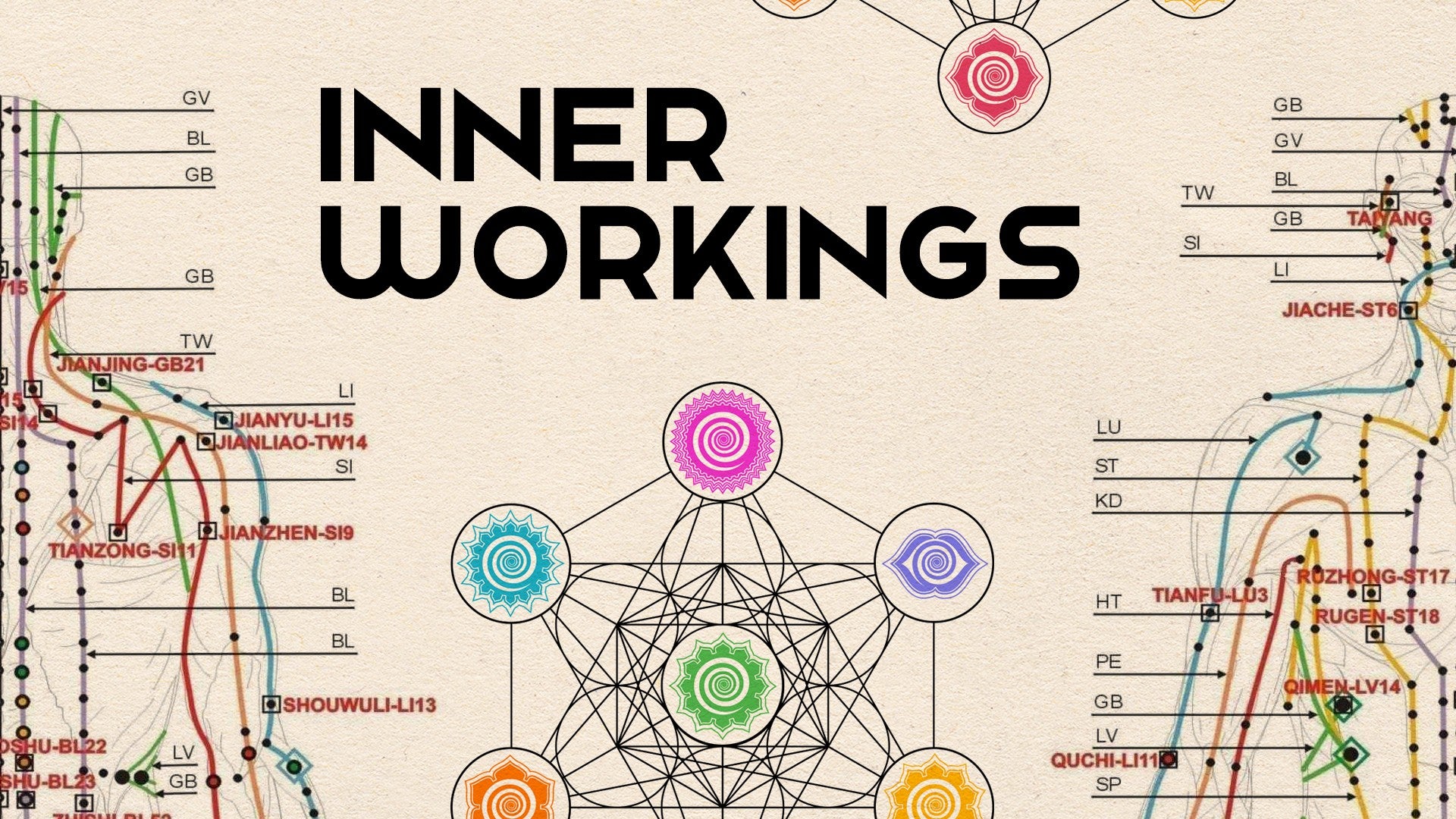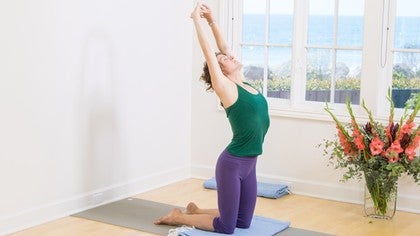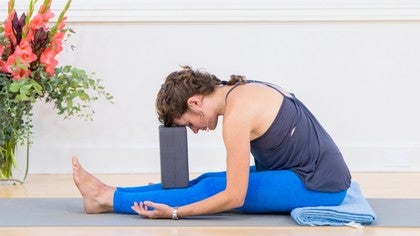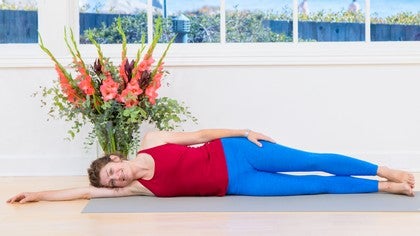Description
About This Video
Transcript
Read Full Transcript
So we've talked about the psoas. We've talked about the pelvic bowl and the pelvic cylinder. We've felt into the center of our bodies from the bottom of the spine to the top of the spine. What I want to do now is feel the spine as a whole and specifically I want to feel the front of the spine. So the psoas travels next to the front of the spine on either side in the lower spine. The diaphragm is attached to the front of the spine and the sides of the spine. The the front portion of the spine is these round shapes, they're called the bodies of the vertebrae and in between are the discs and that's where the weight moves from the skull into the pelvis where it gets directed into the legs. The back of the spine, the part that you can feel from the back and that we often picture the the pokey part, my teacher Amy Matthews refers to that as like the steering wheel. That's where you drive from but you want to drive away from where the majority of the weight is sitting. And so we want to feel into the front of the spine and feel how to allow the weight to move in the front of the spine so that the energy, the release of energy upward and outward in the body can be unencumbered by holding weight. So the first thing that we're going to do is just feel for weight, for the weight of our bones, for the weight of our tissues, and for the support of the floor. And while we're doing that you can come into and I'll talk about the locations of the chakras and the quality of our embodiment around them. So the first thing we're going to do is just come down onto our bellies, lie down onto our bellies. Now the classic yoga posture for being on your belly is makrasana and if you want to be able to have your head straight, your neck straight, you can rest the forehead in the hands like this. That's totally fine with me. My tendency when when I'm seeking yield, when I'm really feeling for my ability to connect with support, I turn the head and turn the palms over because this is how babies sleep. So this is it. We're gonna be here for a little bit and you can always turn the head the other way. You can always come to makrasana. You can wiggle around, seek your own comfort, but also give yourself enough time to settle. My experience in my own body is that the more often I practice yield, the more quickly I can step into the space of feeling support and and the space of feeling my own ability to encourage the presence of support by giving my weight. But depending on how the rest of your day has been, on the tone of your tissues coming in, on the quality of time that you've allotted yourself to do this practice, it may take a long time to feel settled and that's okay. Even if you do this practice with me for a little while and you don't feel fully settled, it's still practice and you still did the time you did. Now I find for myself that when I'm looking at you when I'm engaging, it's hard to be in my body in a way that really facilitates yield, in a way that really lets me feel how wrapped around my own center I am. And so I really encourage you in this practice to look away from the screen, to close your eyes and go inside. Feel for the places where you're holding yourself.
It may be that that holding is necessary for you today, but it may also be that letting go of that holding is what you truly want. So I'm gonna transition to my side. We're gonna keep doing this practice of yielding in the sideline direction. So my right arm is underneath my right ear. I'm lying on my right side and I can really feel the side of my right thigh bone, my right greater trochanter against the floor and there's kind of a balancing action that happens around that. And if that balancing action is very distracting for you or feels like you just keep working on it, you can always bend the knees, use the the bend in the legs or even the hand to aid you. Gradually we're looking to come into a position that feels very bisectable. So the more that my legs are straight and the more that my arm rests on top of my thigh, the more I can imagine a line, a plumb line, cutting straight through my body from heaven to earth, dividing me into sort of front and back sections. And the point of that plumb line is to be able to yield along it. That's the line where we're looking for the centers.
And we're looking for the front and the back of the body to be held toward that line, relatively effortlessly. Doing this practice has helped me notice when I get in bed at night and I come on to my side, very often there's a curl but it's especially, which is very natural, but there will be a special tendency for my head to be quite forward. And when I'm able to notice that and shift my head into being in line with my spine, I feel this wonderful sense of releasing the intensity of the day. The principle of yield is to find support by giving weight, to be free not only to get up but to lie down. And they facilitate each other, right? Our ability to rise up from the earth, to move freely, to feel empowered, is really just the other half of the same path or one direction on the same piece of road or a piece of muscle. As our ability to receive, to lie down, to be supported. So let's do the other side. You can make your way back to your belly and on to your left side. You're probably getting mellow enough now to notice where your intention begins. So when I suggest that you move, what moves first? What happens in the brief tick, in the second before the movement begins? Where do you start?
One thing I'm really noticing here is how much easier it is for me to rest on my left side than my right. I'm feeling into the centers at the front of the spine. And trying to allow the yield that I can feel from the left side into the floor to travel all the way up into the right side of the body. To help create spaciousness there. And then let's come over onto our backs. So right now you might feel into where the impulse is. To come onto your back. How are you going to accomplish it? Is it just a collapse? Is it very orchestrated? And we'll practice supine yielding. We did a longer version of supine yield in the constructive rest position with the knees bent in another episode. And I offered both more time and more thoughts about the experience and the process.
And that piece can fit with any other piece of your practice. You might be surprised to find that consciously increasing your experience of weight can really invigorate your practice. Also it's wonderful just for itself. So let's come out and we're gonna make our way up to stand. And before you start to move I'll ask you to sort of observe in your mind the process of you getting up to stand. How do you, not really when you think about it, but just when you very first imagine yourself getting up, what does it look like? How are you going to shift your relationship to gravity? It's fascinating to me that we weigh the same in all our positions, right? So you'll just be passing the weight with your centered grounded self, with your awareness of the spine from the tip of the tail to the crown of the head and now you can get up. I chose to roll back onto my belly to come to hands and knees, to rock back onto my feet and to stand up. You may have sat up from lying down, you may have used one leg to step up and out. I'm not really interested in one way over another right now. There are so many ways and so many goals and so many feelings. We're standing and the weight is dropping from the crown of the head through to the soles of the feet and what I'm curious about is can you experience yields from here? The bones in your straight legs have the capacity to pass weight from bone to bone in such a way that only very minimal adjustments are necessary to keep you here. The spine undulates so that as we come up from the leg bones into the pelvis and the pelvic halves, the iliac arches are part of the legs functionally, developmentally. We come from the legs, from the iliac arches, into the sacrum which is the transition to the spine. You can feel that tailbone from the inside of the body just by squeezing the anus gently. The tailbone is just behind. It curves out away from the body in the sacrum to balance the contents of the pelvis and then in forward in the lumbar spine until it's just halfway between the front of you and the back of you. Just behind the navel is the body of the vertebrae and then back out again, flaring behind the container for the lungs and the heart, the ribcage, balancing the way that the ribcage moves forward and then it comes forward again so that the body of the vertebrae is just at the back of the mouth. If you put your fingers in your mouth and reach back it would be right there and it's just slightly more forward of that just below in the throat and then up inside the skull above the roof of the mouth that your Ajahnachakra, the spine sort of unfurls into the whole cranium. And as the weight is allowed to travel freely down, the energy that travels through the centers along the front of the spine and everywhere in the body is unencumbered. That energy which is entirely yours and at the same time not yours at all. My teacher Swamiji used to say, yours to use, not yours to keep.
Thank you for coming to practice. Namaste.






You need to be a subscriber to post a comment.
Please Log In or Create an Account to start your free trial.